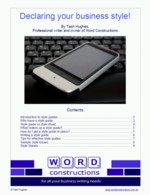Business writing, well good business writing, is made up of a lot of elements. One important element that isn’t mentioned very often is consistency.
While consistency in style, design and so forth are important, I am talking about consistency within the content itself.
It can be consistency in spelling (advisor or adviser?), capitalisation (Internet or internet?), hyphenation (multi-media or multimedia?), abbreviations (A.T.O. or ATO?) or apostrophes (CDs or CD’s?) Sometimes there is a right or wrong way, but in other cases either way is acceptable. However, switching between them in the same document or on your website can be distracting and even annoying. It also doesn’t send a good message about your attention to detail.
Let’s take the example of adviser and advisor. Both are acceptable spellings of the word, although some dictionaries list advisor as the American spelling; adviser tends to be more common in Australia.
If you are writing a webpage about your services as a business adviser, it is likely you would write adviser quite a few times. And by the time you have written the entire website, you will probably have used adviser at least a dozen or so times.
Now, if you have a strong preference for writing adviser, it will be easy and you probably wrote adviser every time. Likewise if you prefer advisor.
But what if you can never remember which is the ‘right’ way? Or you prefer adviser but whoever wrote the older webpages used advisor and it’s hard to remember which to use.
How can you remember which way to spell adviser? And at the same time remember to keep everything else consistent?
One way is to prepare yourself a style sheet.
How does a style sheet work?
Your style sheet can simply be a list of things to watch out for, or it can be a grid with each square being a letter of the alphabet so you can sort the things to watch out for.
An example style sheet is:
Style Sheet for Word Constructions Blog
Adviser
CDs
database
e.g.
internet
multimedia
program
Next time I need to write about a multimedia program within my blog, I just check that style sheet for the appropriate spelling.
Style sheets can be particularly useful if you have more than one entity to write about. You might have a style sheet for your job and another one for your own business, or maybe you need a style sheet for each client.
Company and product names can also be included in a style sheet as getting these names correct is an important part of branding.
The time it takes to create a style sheet will be paid for by having greater consistency in your writing. And a style sheet makes a great starting point for a style guide later on.

 A style guide is simply a set of rules as to how your business produces it’s communication materials (including website content, letters, emails, marketing documents and promotional articles.)
A style guide is simply a set of rules as to how your business produces it’s communication materials (including website content, letters, emails, marketing documents and promotional articles.)

Recent Comments